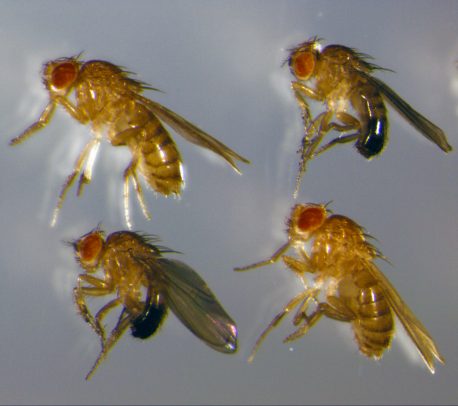Malnourished fruit flies preserve genital size to ensure reproductive success
In most animals, body size shrinks when food becomes scarce, but some parts are protected from shrinkage. In humans without enough food, the body becomes small, but the size of the head stays the same, hinting at biological mechanisms that act to preserve the all-important brain.

In arthropods such as the fruit fly, whose lifespan is about 45 days and where reproductive success is the sole purpose of its life, the size of the male genitals are preserved under poor nutritional conditions. Males that can maintain their genital size when food availability is low are more likely to reproduce because for female fruit flies, size matters.
Now, researchers from the University of Illinois at Chicago and Loyola University in Chicago report that male “genital sparing” during times of inadequate nutrition is due to lower levels of a negative growth factor called FOXO in the genitals under such conditions, and that this phenomenon is directly linked to preserving reproductive success. Their findings are reported in the journal Biology Letters.
“FOXO acts like a brake on growth and size maintenance,” said Alexander Shingleton, associate professor of biological sciences at UIC and senior author on the paper. “When a fruit fly is starved, the activity of FOXO goes up throughout its body, but not in the genitals, and because of this, they are spared from the shrinking effects of malnutrition.”
Previous research suggests that female fruit flies not only prefer to mate with males with larger genitalia, but males with small genitalia may not be able to physically interact with the female genitalia properly, reducing the likelihood of successful reproduction. Some research suggests that females may also reject the sperm of males with smaller genitalia.
When Shingleton and colleague Austin Dreyer, a postdoctoral researcher in the biology department at Loyola University and corresponding author on the paper, increased FOXO activity in malnourished male fruit flies’ genitalia, the genitalia decreased in size by 29%. These males were also 26% less likely to mate with females, but when they did, they produced 50% fewer offspring.
“Our findings suggest that there has been significant selective pressure on limiting the amount of FOXO in the genitals of male fruit flies as a way to ensure reproductive success, given the female’s preference for mating with males with larger genitals,” Shingleton said.
“What makes our research especially significant is that it links changes in the expression of a gene, FOXO, to the selective pressures that drive changes in the expression, male mating success. This is one of very few studies that have been able to do this for any evolved trait,” Shingleton said.
This research is supported by National Science Foundation grants IOS-0919855, IOS-0845847 and IOS-1557638, and National Science Foundation cooperative agreement DBI—0939454.
